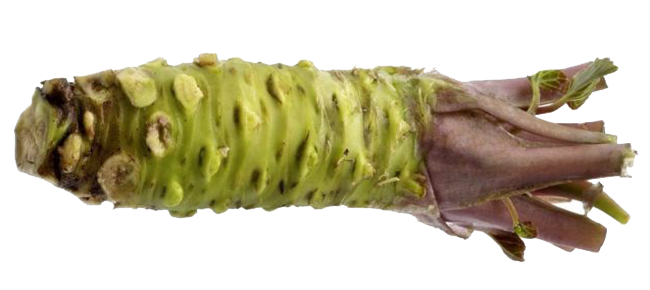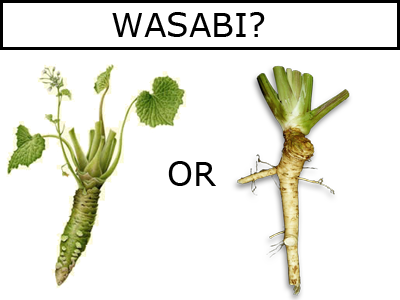Nutraceutical & Medical High Activity Powders
Wasabia japonica (Eutrema japonicum) has been found to have remarkable Medical and Health benefits.
A large number of independent peer reviewed Scientific studies have been published that demonstrate that Wasabia japonica has significant Health Benefits for many medical conditions.
Wasabia japonica is a plant .
Wasabi is a mixture of Mustard, Horseradish and artificial colouring.
What is the difference between Wasabi and Wasabia japonica (Eutrema japonicum)?
The most important thing to know about the difference is that Wasabi japonica has no allergens and has scientifically supported health benefits and wasabi does not.
In fact most wasabi contains artificial colouring and additives that have been shown to cause health problems.
Wasabia japonica is also known as Eutrema japonicum.
In most peoples minds Wasabia japonica and Wasabi are interchangeable.
But, the reality is totally different. It is like comparing chalk to cheese.
The words are similar and yet that is where the similarity ends.
Wasabi is the word used to describe the pungent green paste that really clears out your sinuses when you eat a lot of it in one go. Have a look at videos on the Internet to see the stupidity that some people inflict on themselves and others relating to the consumption of wasabi.
Wasabia japonica is a plant that can be grown in water or in the soil, is green in colour, is shaped like a knobbly carrot and grows on top of the ground.

How does this confusion come about?
After all the word “Wasabi” is now part and parcel of everyday language irrespective of what language or dialect you may speak. Who doesn't know about “Wasabi Peas” for instance?
The fact is that the word Wasabi has now entered the normal vocabulary of entire nations, and the populations understanding of that word is that it is a food condiment, usually used with Japanese food, but now being used as a spice in almost everything.

The acceptance of Wasabi is similar to the way that Pork was introduced to the English by William the Conqueror back in the 11th Century. As they were French speaking nobles, they used the word “Porc”, which is French for pig to describe some cooked meat dishes. The servants picked this up and started referring to cooked pig as Pork. From these small beginnings pork entered the English language.
A similar thing has happened with Wasabi. Instead of the word coming from the French, this time it came from the Japanese via the Allied soldiers going home after World War II. However, in my view this was not an unintentional language mis-translation, but a deliberate mis-direction, as the plant Wasabia japonica was (is) regarded as a national treasure in Japan and needs to be protected.
Wasabi has been shortened from seiyō wasabi which means Western Wasabi. This is the powder that the Allies brought back from Japan after the war as the new spice they had discovered overseas. The real Wasabia japonica was hidden away in the mountains, far from the eyes of the foreigners.
The seiyō wasabi was (is) exactly what it says. It is dried western horseradish (Armonicia rusticana) that was mixed with dried seaweed to change the colour and make it look different to plain dried horseradish powder.
These days Wasabi powder is still made from Armonicia rusticana, and now it is still not likely to contain any Wasabia japonica but may contain mustard powder, corn starch, various colours and other flavours – such as chilli.
From the man in the streets point of view, it doesn't matter what it is made from. So long as it has the accepted taste and action of Wasabi, namely the nose tingling rush and eye watering ability, then it is regarded as Wasabi no matter what the ingredients are.
Now this is where the Wasabia japonica differs.
Wasabia japonica is a plant that has a large number of species that are grown in a number of places throughout the world.
Each species has a different chemical makeup, although a definitive series of scientific studies have never been undertaken to determine what (if any) these differences might be.
It has been shown that the Wasabia japonica plant always contains three unique Isothiocyanate compounds. These compounds are listed as;
6-methylthiohexyl isothiocyanate,
7-methylthioheptyl isothiocyanate, and
8-methylthiooctyl isothiocyanate.
It is these unique compounds contained in the Wasabia japonica plant, and in no other that gives this plant amazing health benefits with no side effects.
What does this mean?
It means that using Sawa 100% Freeze Dried Pure Wasabia japonica rhizome powder for any Nutraceutical or Medical use will provide the maximum health benefits for the user.
The rhizome contains the highest level of the 3 unique compounds mentioned above.
Sawa Wasabia japonica main Benefits
Sawa 100% Pure Wasabia japonica rhizome powder
benefit 1
The customer will get maximum health benefits from the consumption of Sawa Wasabia japonica powder.
BENEFIT 2
With no fillers the customer will get the maximum benefit from the high levels of the active ingredients in the Sawa 100% Wasabia japonica rhizome powder.
BENEFIT 3
Does not contain any additives of any kind, just 100% Pure Wasabia japonica rhizome powder. The rhizome contains the highest level of active ingredients.
BENEFIT 4
There is a large amount of Scientific support for a range of different health and medical conditions.
BENEFIT 5
There are no known side effects or allergic reactions to consuming Sawa 100% Wasabia japonica rhizome powder.*
BENEFIT 6
FDA recognises this product as Generally Regarded As Safe (GRAS) for human consumption in any form.
* This product is not recommended for consumers who are allergic to Mustard Oil. While our product does not contain Mustard as an ingredient, when mixed with water or consumed it does produce Mustard Oil (Allyl Isothiocyanate). This is a natural reaction of the plant as part of its own protection mechanism. For manufacturers we recommend that they add a warning on their labels to this affect. The EU and other countries require that any product that contains Mustard Oil as an ingredient has an allergy notice. Please check with your own State or Country requirements. Some users have mentioned of having mild heart burn while using this product.
Get started now!
Contact us now for more information.
What Makes Us Different
Since starting growing Wasabia japonica in 1990 our company policy is that we would concentrate on Quality over Quantity. We have adhered to that policy for over 30 years.
To that end we do not add anything to the Sawa 100% Pure Wasabia japonica powders we provide. They are all from the actual plant with no diluents, excipients, colours or flavours.
These are as Pure as it is possible to produce.
Frequently asked questions
There are many health benefits that are impacted with the addition of Sawa 100% Pure Wasabia japonica to a diet. Either as a supplement or as part of a medical regime. A list of the published peer reviewed scientific papers is available on request.
The powder is produced by Freeze Drying. This is a method which removes only the water content from a plant without removing any nutrients or active ingredients. The active ingredients are activated by the addition of water when the powder is consumed.
There is no need to use any solvents which tend to leave small residues of the solvent.
Everything in this product is all natural and comes from the plant itself. The green colour of the powder is the natural colour of the rhizome. Nothing is added or removed from the powder except water.
There is only one ingredient and a single piece of the Wasabia japonica plant used in this product. This piece is the rhizome or swollen stem which contains the highest level of active ingredients in the plant. The other parts of the plant - leaves, stems and roots are not included in the Sawa 100% Pure Wasabia japonica rhizome powder.
A Certificate of Analysis (COA) is available for each batch produced. A COA is included in every shipment dispatched. An example of a COA is available on request.
The Harmonised Tariff System number for importing and exporting this product worldwide has been accepted by most countries as 1211.90.9290.
This relates to the medical use of the product due to its scientifically shown health benefits.
There are no known side affects of consuming Sawa 100% Pure Wasabia japonica rhizome in any form. It should be noted that people who are allergic to Mustard and spicy foods should avoid consuming this product.
The short answer to this is NO!
The wasabi in your cupboard is a mixture of Mustard, Western Horseradish, artificial colouring and other filler powders. It has no significant health benefits apart from making your nose run and eyes water.
It is the 3 unique chemicals that are only found in the Wasabia japonica plant which makes it the powerhouse it is for what ails you.